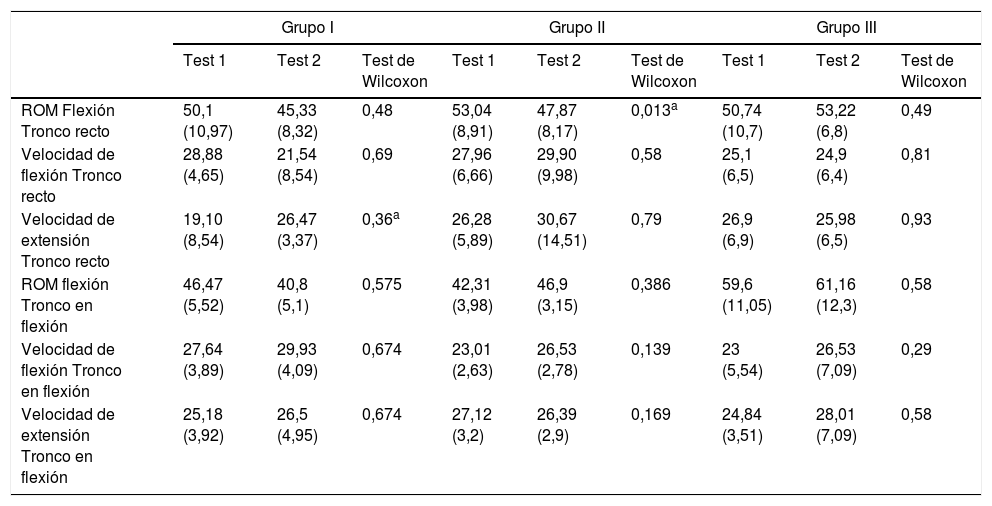El fenómeno de flexión-relajación en columna cervical (FRc) no tiene la misma difusión clínica que el test lumbar. La respuesta de los músculos cervicales es menos evidente.
Tanto el protocolo de evaluación como la instrumentación utilizada tienen influencia para alcanzar un valor de fiabilidad con validez clínica.
Se plantea un estudio test-retest en 3 condiciones distintas, para definir un protocolo de valoración idóneo.
Material y métodoSe evalúan 3 grupos con 9, 11 y 10 voluntarios, respectivamente, en un test-retest efectuado con un intervalo entre 7 a 14 días. En el grupo i, se evalúa la prueba con electromiografía de superficie (EMGs) bipolar, sin control del movimiento. Para el grupo ii se usa electrodo bipolar, con control de la velocidad de ejecución y una leve ayuda para estabilizar el tronco. En el grupo iii, se controla la velocidad, se aumenta la estabilización y se usa un electrodo tetrapolar.
Como variables de resultado se toman la ratio de flexión-relajación y su logaritmo neperiano. Se efectúa un test sentado con el tronco recto y otro en flexión a 45°.
ResultadosPara el grupo iii las 4 variables obtienen valores en el coeficiente de correlación intraclase (ICC > 0,80). En el grupo ii, el ICC estaba comprendido entre 0,3-0,6. Para el grupo i, las 4 variables fueron muy inferiores a 0,3.
ConclusiónCon una adecuada estabilización de la postura, control de la velocidad y adecuada instrumentación de la prueba, puede objetivarse una respuesta de FRc. Definir un protocolo fiable permite avanzar en el uso clínico del test.
The cervical flexion-relaxation phenomenon (FRP) is not as well-known as the lumbar test. The response of the cervical muscles is less evident. Both the ASSESSMENT protocol and the instrumentation used influence the achievement of a reliability value with clinical validity. We conducted a test-retest study in 3 different conditions, to define a suitable assessment protocol.
Material and methodThree groups were evaluated with 9, 11 and 10 volunteers, respectively, in a test-retest study with an interval between 7 and 14 days. In group i, the test was assessed with a bipolar electrode of surface electromyography (EMGs) and without movement control. In group ii, we used a bipolar electrode, the speed of the movement was controlled and we introduced a slight help to stabilise the trunk. In group iii, speed was controlled, stabilisation was increased and a four-pole electrode was used. As outcome variables, we took the flexion-relaxation ratio and its neperian logarithm. A sitting test was performed with the trunk straight and another was conducted with 45° flexion.
ResultsIn group iii, the 4 variables obtained intraclass correlation coefficient values with clinical validity (ICC > 0.80). In group ii, the ICC ranged from 0.3-0.6. In group i, the 4 variables were much lower than 0.3
ConclusionA valid cervical FRP can be obtained with good stabilisation of posture, control of speed and suitable instrumentation of the test. Definition of a reliable protocol would increase the clinical use of the test.
Artículo
Comprando el artículo el PDF del mismo podrá ser descargado
Precio 19,34 €
Comprar ahora











